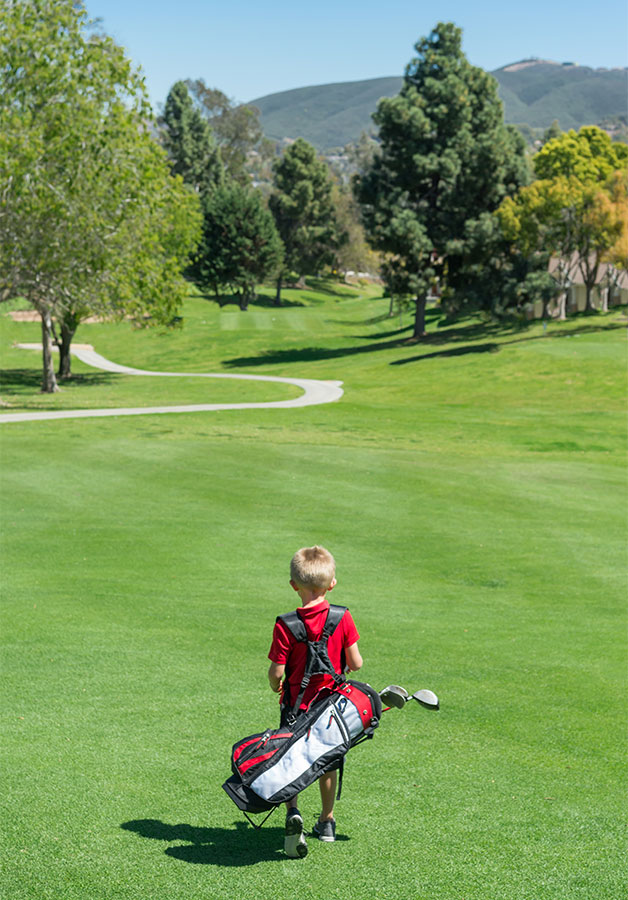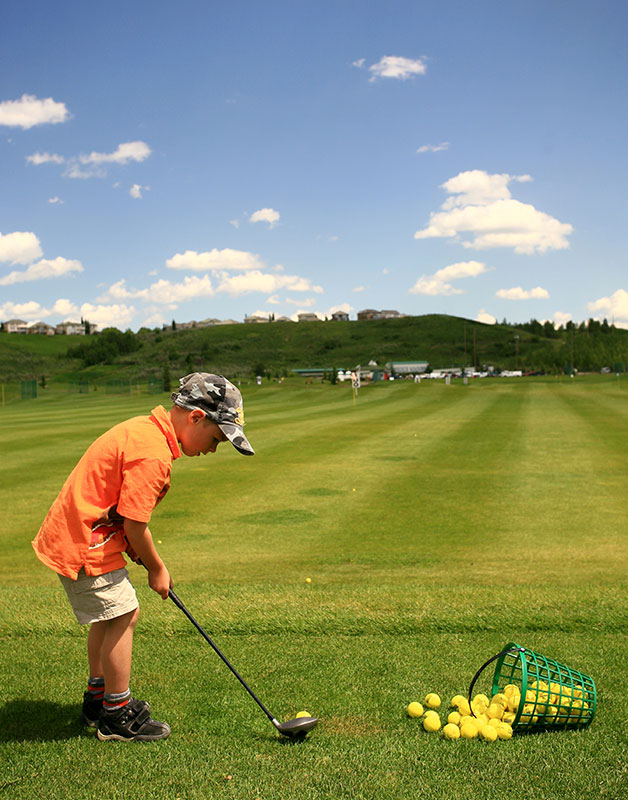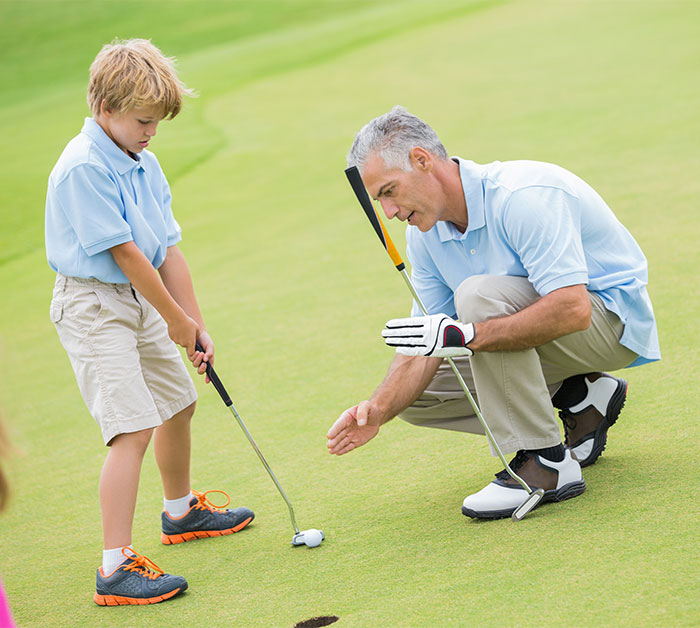Every weekend, little boys accompany their fathers for a round of golf. For five-year-old Adam Scott it was his father Phil, an accredited PGA professional, who used to take him to North Adelaide Golf Course to play an 18-hole par-3 layout on the banks of the River Torrens.
Young Adam took to the sport like a duck to water, such that his nickname was “Golf” at high school. By the age of 32, Scott had become Australia’s first Masters champion with his thrilling victory at Augusta National in 2013.
Of course, not every little boy has the benefit of being introduced to golf and encouraged by a parent who is a PGA professional. That’s the great challenge for golf administrators as they seek to increase junior numbers at a time when traditional sports face a range of societal pressures, particularly with regard to available recreation time.

Decline In Club Membership, Rise In Participation Numbers
The pressing need to introduce more juniors to the game follows the release of ‘The 2018 National Golf Club Participation Report’. Just 12,778 juniors are members at clubs across Australia. That represents 3.3% of the total club membership of 383,613.
Regional areas comprise 212,047 members while 149,420 members belong to metropolitan clubs. But club membership has continued to decline by a rate of 1.6% across states and territories. Only Western Australia (+1.7%) and South Australia (+0.1%) defied the downward trend.
Club membership across the country has dropped 23.4 percent since the end of the participation boom inspired by Greg Norman. Membership peaked at slightly more than 500,000 in 1999 (which, incidentally, was the last time Greg Norman registered top-10s in two Majors in the same year).
The good news is that more people are playing rounds of golf. Club competition rounds increased by 1.5% to 10.32 million (as recorded by GolfLink). The average number of competition rounds per member has risen to 26.9 rounds.
Overall, we’re seeing golf participation increasing, according to the government’s annual Ausplay data. Golfers comprise 4.9% of the population (aged 15 and older) according to Ausplay, which estimated 945,900 Australians played golf in the
past year.
The message to be gleaned is that club golf remains vital to regional communities and golf is still the most popular club sport for adults, says David Gallichio, Golf Australia’s general manager of golf development. What we’re seeing is a trend away from the traditional club membership, he says. The challenge for Golf Australia as a national sporting organisation is making sure our offerings line up to what customers are wanting and how they want to consume golf.
 A trend is towards flexible memberships. For instance, Bathurst Golf Club in New South Wales’ central west has boosted its membership by 15 percent during the past five years. The club has offered multiple price points, flexible payment systems and three-month or six-month memberships that cater to people for whom golf is their second sport. Club professional Matt Barrett has done a great job of linking with the local community and striking partnerships with schools to bring a lot more juniors to the club.
A trend is towards flexible memberships. For instance, Bathurst Golf Club in New South Wales’ central west has boosted its membership by 15 percent during the past five years. The club has offered multiple price points, flexible payment systems and three-month or six-month memberships that cater to people for whom golf is their second sport. Club professional Matt Barrett has done a great job of linking with the local community and striking partnerships with schools to bring a lot more juniors to the club.
MyGolf Leading The Way For Junior Participation
At first glance, junior numbers appear depressing. At just 12,778 in the club system, the obvious fear is that golf won’t be able to replenish the current number of golfers and sustain the game’s future.
However, it’s difficult to measure how many kids actually play golf. A child in a soccer team has to register with the state body, which knows exactly how many kids are playing in various age divisions. Because golf clubs are separate organisations they don’t always record or pass on that information.
For instance in NSW, junior members of clubs number between 5,000 and 5,500. However, Jack Newton Junior Golf estimates there’s another 4,000-5,000 involved in ‘clinic’ programs at clubs that aren’t actually registered members. These kids don’t have a handicap but they’re involved in the game. And through the school system another 20,000-25,000 children are introduced to golf through ‘sporting schools’ or generic programs.
The primary driver of junior participation is MyGolf, a joint venture between Golf Australia and the PGA of Australia. MyGolf is the national introductory junior program based at clubs, run predominately (about 90 percent) by PGA professionals. It is the single largest investment into the growth of the game by Golf Australia and the PGA, and is the No.1 priority for both organisations from a development perspective.
Children between the ages of 5 and 12 can become involved by visiting mygolf.org.au and entering their postcode to find the nearest MyGolf centre. Some clubs will have as many as 10 programs based on day/time of the week. At any one time, 300-400 clubs are actively involved in running a MyGolf program.
MyGolf term lengths usually range from eight to 11-week sessions. Each session is about an hour in length and the median price is about $100 per term. Every child receives a gift pack, which includes a drawstring backpack, a cap, a golf club and a PVC ball. (The club is a custom-made 7-iron with an oversized forged head and graphite shaft.)
MyGolf numbers are very encouraging, exceeding the expectations of Golf Australia and the PGA. As a schools-based product prior to 2014 it had just 3,470 children. Now after transitioning to a club-based program, MyGolf reached 24,000 participants last year. It’s on target to reach 28,000 primary schoolchildren in 2019 and 30,000 by 2021.
Golf clubs and PGA members appreciate the importance of bringing all the state-based introductory programs under one banner. The big challenge facing Golf Australia and the PGA is how to retain those kids who have done one or two sessions of MyGolf.
The big challenge facing Golf Australia and the PGA is how to retain those kids who have done one or two sessions of MyGolf.
“Clubs are understanding there needs to be a junior-friendly environment,” says Gallichio. “And that’s everything from course access and membership options all the way down to offering MyGolf programs and entry points into the game.
“The stats are extremely clear that when kids experience a sport at a young age, they are more than twice as likely to come back to that sport at a later date. The bottom line is the more kids that are coming through a junior development program such as MyGolf, the bigger the membership pipeline will be into the future.”
“When kids experience a sport at a young age, they are more than twice as likely to come back to that sport at a later date.” – David Gallichio, Golf Australia
Sport Australia (previously the Australian Sports Commission) has been very supportive and actually provided the initial funding for the original design of MyGolf. However, securing commercial support and partnerships is the key to going to the next level.
Adds Gallichio: “By our estimation, once we hit just over 30,000 participants we are then going to really need to start growing the amount of kids that are playing golf for the first time. We’re going to need to invest in bringing new kids into the game and that is going to be time-consuming, expensive but critically important work.”
Why Don’t Kids Stick With Golf?
Once you’ve got children interested in golf, the next challenge is keeping them interested. Why do kids drop out as teenagers? For the same reasons kids drop out of a lot of sports: they become lazy, they’ve got hormones and they’re introduced to new things. That’s part of growing up.
“The whole nature of getting kids into sport is far more difficult now than it used to be,” says Peter Van Wegen, chief executive of Jack Newton Junior Golf. “And that’s partly because of technology – iPads, iPhones and games – and partly because the school system doesn’t promote sport as it used to.”
“The whole nature of getting kids into sport is far more difficult now than it used to be,” – Peter Van Wegen, Jack Newton Junior Golf
Jack Newton Junior Golf in NSW is the pre-eminent development pathway through until 18 years of age. It stages tournaments, provides talent identification and is involved with regional academy of sport programs as well as covering travel expenses for elite juniors to attend interstate and overseas events. (All the other junior foundations – such as the Greg Norman and Stuart Appleby bodies – have been incorporated into their respective state associations.)
 JNJG has developed a whole stack of different types of programs to encourage kids to participate. For instance, junior golf never had the resources or the profile of the football codes to pay somebody to do some sort of program at a school. So JNJG developed a teacher-training program, which paid teachers to deliver golf. JNGF had success with that initiative and generally attracted teachers with an interest in golf.
JNJG has developed a whole stack of different types of programs to encourage kids to participate. For instance, junior golf never had the resources or the profile of the football codes to pay somebody to do some sort of program at a school. So JNJG developed a teacher-training program, which paid teachers to deliver golf. JNGF had success with that initiative and generally attracted teachers with an interest in golf.
However golf has now lost its competitive advantage over other sports. NSW schools can now apply to receive funding for a particular sport to be delivered to their school. And they can choose one of 32 sports. All of a sudden a school that used to choose football (and sometimes golf) can now choose badminton, surfing and ice-skating as long as those sports can provide an instructor to deliver that program. (Typically, the school pays $88 an hour to the instructor.)
Demographics have also changed. A lot of immigrants from ethnic backgrounds don’t have sport as a priority for their kids. Hence, golf’s potential market doesn’t necessarily correlate to Australia’s rapid population expansion during the past two decades.
But that’s a challenge faced by all sports. The trouble with golf is that it’s a much more difficult sport to learn by comparison with a bunch of kids trying to kick a football. And, generally speaking, golf clubs tend to have certain restrictions that discourage kids.
In order to nurture and retain juniors it’s paramount that clubs build an environment conducive to them: “The reason that kids go to soccer as 6, 7 and 8-year-olds is because there are another 10 or 12 kids there and they can have a bit of a run around, and they can have a bit of a yell and a scream and then go home. Sport isn’t necessarily the major attraction,” Van Wegen says.
So the whole dynamics have changed, making it harder for golf to appeal to schoolchildren. Hence, more needs to be done at club level. Beverley Park Golf Club in Sydney’s southern suburbs had just two registered juniors when Paul Davis took over as club professional in 2018. That figure has expanded to 52 in the space of 18 months.
While some juniors migrated from neighbouring Bexley Golf Club where Davis was the pro, the vast majority came to Beverley Park off the back of a concerted marketing campaign that targeted juniors through advertisements on social media channels (Facebook, Instagram, WhatsApp and Google) as well as MyGolf and JNJG.
Beverley Park’s most significant innovation has been to introduce an open junior competition for one Saturday each month. Some 32 spots are allocated to juniors who travel from across the city to be a part of ‘Kids Playing With Kids’. Through word of mouth, the open day is now attracting juniors from top-end private clubs. “Kids want to play with one another,” says Davis.
Initially, Beverley Park thought some members might object to a large portion of Saturday tee-times being reserved for kids. But its ageing membership has embraced a concept that sees the clubhouse filled with children and parents for the announcement of Saturday competition results.
 Not All Doom And Gloom
Not All Doom And Gloom
Golf is a difficult game, it’s a time-consuming game, but it’s not an overly expensive sport for beginners. It’s when you start to get better and want to play more and join a club and upgrade your equipment that it starts to get a little more expensive. Parents will pay for golf because it’s a great environment for their kids to learn. It’s disciplined, there’s interacting with adults that beget good social skills.
So it’s not all doom and gloom despite juniors making up just 3.3% of club golfers. However, providing enough beginner-friendly courses for kids will be an ongoing challenge. In the foreseeable future the biggest obstacle facing golf administrators may be access to public golf courses. Increasingly, metropolitan courses on public land are under enormous pressure from councils and other landlords to justify their utilisation as recreational ‘green space’.
And, even if another charismatic figurehead such as Greg Norman came along, it’s unlikely that player would have as much impact on the game as the Great White Shark in his prime. Thankfully, initiatives to grow the game are bearing fruit. Junior golf is looking healthier with patriots sowing seeds of growth.
BEST METROPOLITAN GOLF FACILITIES WITH JUNIOR-FRIENDLY ACCESS
Sydney
Palm Beach
Avalon
Terrey Hills Par 3
Castle Cove
Cammeray
Sefton
Rosnay
Rum Corps
Barnwell Park
Bondi
Beverley Park
Canterbury
Fairfield
Lane Cove
Woollahra
Melbourne
Albert Park Driving Range
Albert Park Golf Course
Riverside.
Brighton
Glen Waverley
Morack
Sandringham Golf Academy
Sandhurst
Edithvale
Burnley
Adelaide
North Adelaide
West Beach Parks
Thaxted Park
Flagstaff Hill
Glenelg
Brisbane
Victoria Park
Windaroo
Palm Meadows Driving Range
Nudgee
Oxley
Perth
Carramar
Wembley
Collier Park
Mount Lawley
Gosnells



